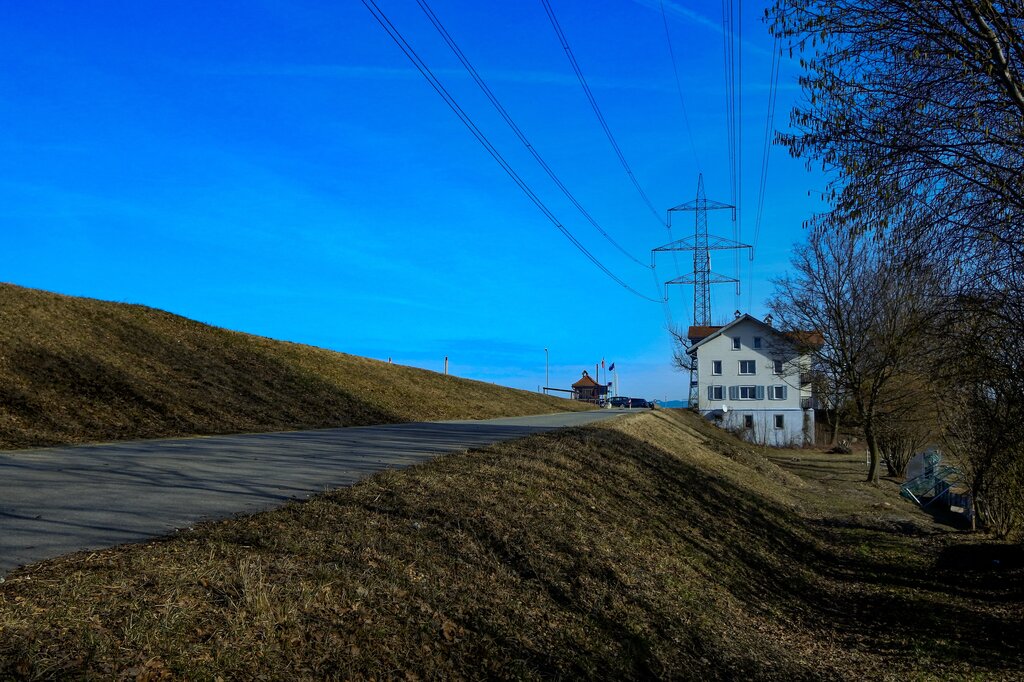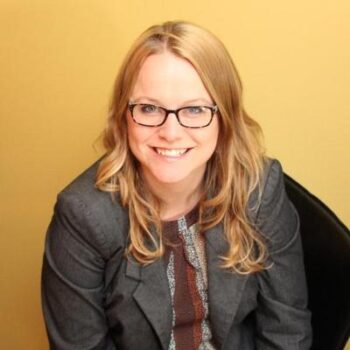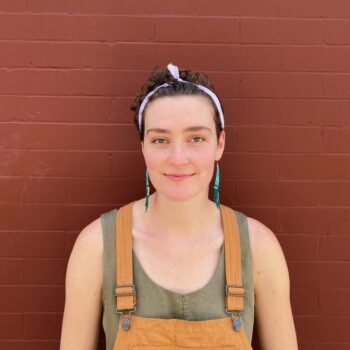In this podcast, the Rural Utah Project’s Madeline McGill talks with Susan Kroger about the challenges of digital organizing in a rural context, the importance of cultural competency in rural organizing, and how to build on this organizing in 2021.
Listen to the conversation here.
The transcript of this interview has been edited and condensed for readability. Click on the link above to hear the full conversation.
Susan Kroger: I’d love to hear a little bit about the Rural Utah Project’s work.
Madeline McGill: The Rural Utah Project is really interesting because it started just as that, as a project. There was an opportunity in Southern Utah in 2018 to flip a seat that had been held by what we’ll call a dominant power for a really long time in a rural space. But what’s unique about this county where this race was, was that it’s been majority Indigenous since the beginning of history and Indigenous people in this place, San Juan County, Utah, the home of Bears Ears National Monument have never had equal representation until the county was redistricted. My organization was founded somewhat spontaneously to help flip this seat. And that was successful. That was the election of Willie Grayeyes and Kenneth Maryboy in San Juan County, which is the first majority Indigenous commission in Utah’s history.
And from there, we saw a pathway and a model by which we might be able to do more important work in other counties in rural Utah. For those of you that are not from Utah, we are a primarily rural state. But the thing that’s interesting about us is that we are considered deeply red but are simultaneously one of the fastest-growing states in the country and are also surrounded by swing states. The landscape in our state is shifting much more than the narrative suggests, and we’re here to try to essentially shift the status quo and see what we can get up to over the next couple of cycles in our state.
SK: That’s the case for so many of the rural organizations I’ve spoken with, that they emerge out of an urgent need in a particular area. You all are in Arizona now as well, correct?
MM: That’s right. Our founding program on the Navajo Nation was originally on the Utah portion. But after our initial success there — and with what I should say is an incredible team of women who are working on Navajo Nation and are led by our field director, Tara Benally — we expanded into Arizona at the end of 2019.
SK: Right. And of course, Arizona is an absolutely critical state and one that has a lot of eyes on it currently. What’s your role in the organization?
MM: I’m super lucky to be our communications director. I have what I consider my dream job. I get to work telling stories about folks that live in underrepresented areas and try to shift the narrative around organizing rural spaces. Which I think is really fun.
SK: There isn’t much else that’s more fun than that. So with COVID this year, I know I’ve had several conversations with organizations pivoting their strategies, trying to think creatively about how to continue to organize and continue to reach out to people, particularly in rural spaces where it was already a challenge to reach large groups of people. And you all have been doing some really innovative work in that space this year. [I’m] wondering if you can spend a little time telling us about that programming and what that’s looked like and how it’s evolved.
MM: Absolutely. One thing that I like about being here is that we are not afraid to try new things and we have the capacity to try new things. You’re looking at a political landscape where technology is rapidly changing the way that we wage modern campaigns. But when you look at those tools, you’ll often notice that they are metronormative. They’re built for organizers in urban areas. Here in rural spaces and on the Navajo Nation, our number one tool is a pen and a clipboard. We’re working offline. We’re working with tools that can be functional offline and therefore, we’ve had to create a lot of workarounds to try to wage a comprehensive campaign in some of these rural spaces.
And one of the things that we often run into [is]: how do people in rural spaces and how do people on the Navajo Nation communicate? Like, where are they online? How are people reaching each other? How are people organizing and turning out? Because what we’ve seen is that these places are ripe with activism. They’re not political deserts. This communication is happening [somewhere] and how can we best tap into it as opposed to relying on structures that are better suited for an urban landscape?
When we talk about politics and digital communication, one thing that we as organizers often fall so heavily on is advertising. It’s been such a boon to have that as a resource over the last ten years. The way that we’ve seen organizations and platforms like Facebook and Instagram change the political dialogue and rhetoric has been transformative, both for wins and losses in terms of modern democracy. But when we look at rural spaces, you’re looking at a small community where everyone knows each other, maybe it’s a town of 2,000, maybe it’s a town of 250, but the communication networks are extremely intimate.
Therefore, when you were an organizer or an advertising organization trying to impart a message onto these communities, doing it from an untrusted person or organization will not carry your message in the way that you need it to. Instead, what we should be doing is investing in the people in those rural spaces that are already doing the work and already sharing the message. So when we came into Arizona and we said, “All right, we have a pool of funding in order to reach people online, how should we use it?” It became quite obvious. It’s, “Oh, we should invest in creators and activists and communicators who are already spreading the message in their communities.” And thus, the Digital Organizing Program was born.
SK: It sounds very similar to an influencer campaign, right? Taking that idea and plugging it into a political organizing model. I would love to hear more about these people who you tapped to help you organize.
MM: Oh, yeah. This is the best part of this, is the people. First, just a bit of nitty-gritty. When we look at a marketing scheme for how influencers are used to, let’s say, promote a product, it’s all based on this thing called conversions. It’s how many people can you get to your website or get to the checkout? But what this organizing program looks at is actually three different types of online influencers. We have influencers as we know them. Folks that have either a micro or a larger audience of people that we’re trying to reach. But then we have people who are content creators. And we’re talking about name accounts, graphic designers, people who are skilled in creating content that can essentially be used by influencers or anyone who wants to spread a message.
And then the third, which I’m really excited about, we’re calling navigators. And these are folks that may not have the largest online presence but are well connected in their community and can have either cold or person-to-person conversations online saying, “Hey, have you checked your voter registration form? Are you up to date?” Right now, it’s almost seven people who fall into those three categories of a digital organizer.
SK: So, walk me through this. You recruit a new person who has those ties in their community, who you know that people pay attention to. What’s the next step? How do they plug in?
MM: This is actually where it gets really challenging because the thing that you lose in this program is a lot of control. I don’t have control anymore of when something will be placed, who exactly it will reach, and how I can see that people take action. So these digital organizers were actually very intentionally recruited because they report essentially everything back to us in terms of what’s performing well on their own content. And those are metrics that I would never have access to. But once these people were identified, in order to get to this point, there are two things. The first is that we have to, have to, have to compensate creators and digital organizers as well as we would for any other position. The amount of work that it takes to create content and to measure the results of content is so much more of a lift than people, I think, recognize. So the first thing, of course, is we offered to pay people for their really good, really intentional work.
Then the second thing is that we say, “Okay, where are the platforms that you’re strongest? Who would you say makes up your audience? What kind of content are you comfortable posting? What do you think your voice is around the election and voter registration, and how can we use our content creation team to help create graphics and things that you feel comfortable using to organize your audience and your community with?” So every organizer has their own goals, their own message, and their own way of reaching people. It’s not a boilerplate, “Hey, can you post this for $25?” It’s, “Tell me what your strategy is for organizing and let me figure out how I can help fund that and help support your infrastructure,” which is what we try to do with all the places we organize: try to support people already doing the work and using their model as opposed to instituting our own.
SK: Really making it person-centered and then also culturally-centered as well, which is a critical part of any work but particularly when we’re talking about work on reservations. When you’re thinking about this work through a rural lens, it sounds like you’re really leveraging the strengths of rural communities in being very relationship-centric and having so many of those loose connections within one’s community. What’s going well, and do you have any gauge yet on the impact of this work?
MM: It’s going well but not in the ways that we anticipated. COVID aside, we’ve had to pivot the online strategies several times just to find out what works well. So here’s what we know does work well. We know that creating content works really well. We know that there are many artists and many content creators who are well adapted and well situated to create incredible, beautiful content coming up to the election. What we are working on figuring out still is how we get that content out of the hands of nonprofits and even influencers in our digital organizing team and how we really get it into many, many hands.
We have this side of the program called the open posting program and it says, “Hey, if you see this post and you’ve heard about this work and you live on Navajo Nation, fill out this form and we will pay you to promote this content.” It’s like we will give you something or we will essentially let you post whatever you’d like to as long as it falls within our legal requirements. And you send us that post, it could be a status update, asking people to register to vote, it could be using one of our graphics. It could be really a whole host of different things. Send that to us, and we’ll compensate you. So the idea here is that we have micro-posters all over Navajo Nation.
And let me tell you, you would think that people would flock to an opportunity like that, but they don’t. And I think it’s because of similar constraints around: how are we reaching the right people and then how can we make sure that folks feel like they’re participating in a program that’s trusted? And so we found, and this kind of verifies everything that we’ve been trying to work for, is that if I post an ad as the Rural Utah Project saying, “Hey, join this program,” I’ll maybe get 16 bites. But if one of our digital organizing teams goes out and just posts a status to their high school network, we get dozens. And that’s a micro-example of how this program can be successful.
Our goal is to generate a thousand leads for our field campaign. So a team of seven people can go out and convert seven hundred members of their audiences into leads for our field team to then check their voter registration, and we figure out if they’re registered to vote. We are about halfway to that goal with much more time to go before the election and not much time before the voter registration deadline. But considering what we’re attempting to do, I’m really proud of how this program is performing thus far. And we are measuring everything I mentioned extremely closely, so that at the end of this, regardless of whether or not we meet our goal and are successful, we can say, “Hey, this is how you run a program like this. This is what we saw worked, and this is what didn’t work. Let’s try it again.” Because I think in many ways this program is, I hope, innovative, and we can continue to work on it and workshop it for cycles to come.
SK: Coming back to the issue of COVID, I’d be curious how you’re seeing COVID play out, particularly through the lens of this digital work.
MM: I imagine that every campaign in the country right now is struggling with really similar considerations. But I’ll start with what makes me optimistic, which is that COVID hit pause on everything that we do as an organization. We paused for multiple months and essentially just pivoted directly into mutual aid because when you live and work in these communities, there is nothing else that you can do except turn to help your neighbors. And we’re proud that we did that. It hit pause on a lot of our goals for this year, but again, it was the right and only thing to do in the moment. When we came back into our voter registration hats, the thing that we’ve seen is that this pandemic has actually brought many sides of our programmatic work closer together.
Our field team and our digital team have to work together; they’ve been siloed in the past with different expectations and different goals. We had to say, all right, how can we take this incredibly talented [organizing] team and help them through our digital work reach the people they might have reached another way? So that’s been one beneficial pivot that has allowed us to innovate further than we might have.
But then, of course, I can’t really overstate the impact that COVID has had on rural and especially Indigenous communities. When I say Indigenous, I don’t mean that all Indigenous communities are rural. I just mean that we primarily work on the Navajo Nation, which for a time was the hardest hit place in the country. Our organizing team has lost family members and friends and the broader community has lost really bright lights and activists. It adds not just a different level of sorrow, but a different level of urgency. It [also] changes the way that we talk about politics and what the importance is of a federal administration.
SK: As you [look] forward to post-election, how do you see this programming fitting into your larger organization?
MM: We’ve been around now since 2018. This is our first presidential year as an organization, and the funding cycle in this industry is very boom and bust, as we all know. And a lot of attention is paid to the presidential cycle and the impact that it has on the country broadly. The presidential election is extremely important. That said, we cannot overstate the importance of local elections and long-term organizing, especially in rural spaces that for too long have not only been underrepresented but often ignored.
Our mission at the Rural Utah Project is to be in this work for the long game. It’s as important for us to organize for county commission and county clerk as it is for us to organize for the presidential election. Because oftentimes, rural areas are spaces of long-term goals and long-term change. The language and the way that politics has been run in our state cannot be undone in one cycle. There are really important dialogues and campaigns and fights that are happening in towns of two hundred people. And that’s definitely not going anywhere.
If there’s one SparkNotes summary thought of all of this it’s: trust rural people. Trust them to organize their own communities, trust their voices, trust their messaging. All we can do as organizations that support rural people and campaigns is to fund them, to give infrastructure, and lend whatever support they ask for. Because they’ve been doing this for a long time and know what it takes and that can’t be said for folks that don’t live there.
Read the entire issue on Organizing in Rural America.


